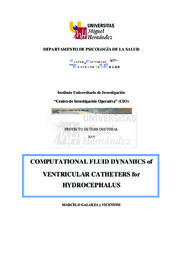Resumen :
Normal-pressure hydrocephalus (NPH) was the first treatable type of dementia ever
described. Hakim and Adams described the entity they called normal pressure
hydrocephalus in 1965 (Hakim & Adams, 1965). Cerebrospinal fluid shunting for
hydrocephalus was the first wide treatment available for the disease. In the following
years, an initially uncritical enthusiasm for cerebrospinal fluid (CSF) shunting was
gradually dampened because of the underdeveloped shunt technology, low clinical
success rates, and frequent complications (Dippel & Habbema, 1993).
The most frequent complication is ventricular catheter obstruction, which may account
for 50 to 80% of newly inserted shunts (Bergsneider et al., 2006). Although many factors
contribute to this (Harris & McAllister, 2012), the main one is related to flow
characteristics of the catheter within the hydrocephalic brain (Harris & McAllister, 2012;
Lin, Morris, Olivero, Boop & Sanford, 2003). A landmark study in 2003 addressed the
problem of fluid characteristics in ventricular catheters (Lin et al., 2003) by using a 2-D
simulation program of computational fluid dynamics (CFD). This study revealed
important information related to this dreaded complication. That is, that the major part of
the flow occurs through the most proximal catheter´s holes.
Currently, to our knowledge, there is no research that has used simulation software in 3-
D CFD to study different models of catheters currently in use, and, new designs of
catheters for the treatment of this disease.So the main objectives of this dissertation are:
- To study flow dynamics in five ventricular catheters models currently in use.
- To create other five new designs of ventricular catheters having different holes
distributions and different hole sizes. In order that these variations in the geometric
characteristics of catheters significantly alter the liquid mass flow that enters the catheter,
avoiding or minimizing the obstruction thereof.
- To study the flow patterns that can be found in the different configurations of
ventricular catheters, by using new models of these.
- To establish a set of universal mathematical parameters that can be used to develop new
designs of ventricular catheters with improved flow dynamics.
To achieve these objectives, current and new models of ventricular catheters will be
studied study by using, never used before for this purpose, a simulation program 3-D
computational fluid dynamics. The general procedure for the development of a CFDmodel involves incorporating the physical dimensions of the system to be studied into a
virtual wire-frame model. The shape and features of the actual physical model are
transformed into coordinates for the virtual space of the computer and a CFD
computational grid (mesh) is generated. The fluid properties and motion are calculated
at each of these grid points. After grid generation, flow field boundary conditions are
applied and the fluid’s thermodynamic and transport properties are included. At the end,
a system of strongly coupled, nonlinear, partial differential conservation equations
governing the motion of the flow field are numerically solved. This numerical solution
describes the fluid motion and properties.
In conclusion, it is intended to simulate the operation of the CSF flow in five ventricular
catheters currently in use and in other 35 new designs ventricular catheters through a
system never used before for this purpose. The parameters for the design of new
ventricular catheters will be established. These variable parameters along the catheter
perforated tip will allow the fluid to enter the catheter more uniformly along its length,
thereby reducing the probability of its becoming occluded. This finding will contribute
to a better treatment of hydrocephalus, including, dementia complex hydrocephalus.
|
 La licencia se describe como: Atribución-NonComercial-NoDerivada 4.0 Internacional.
La licencia se describe como: Atribución-NonComercial-NoDerivada 4.0 Internacional.
.png)
